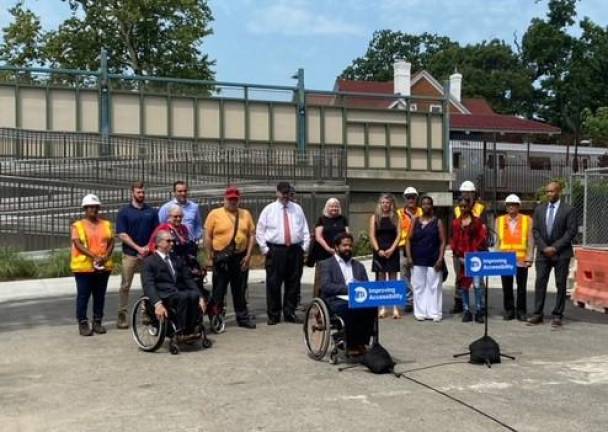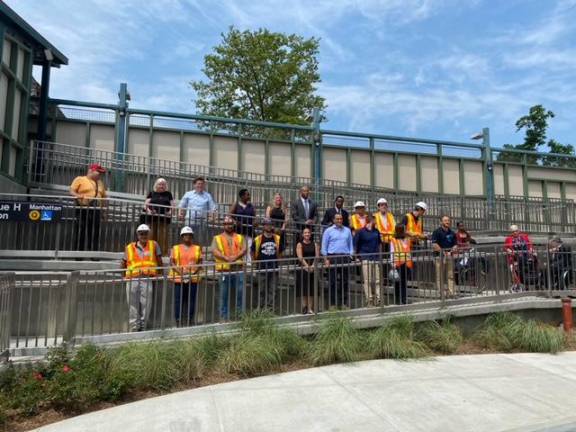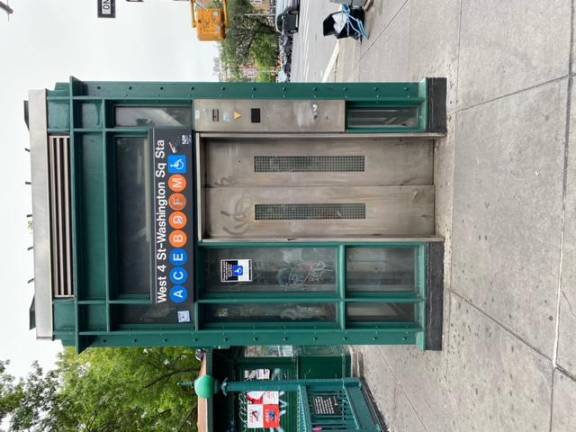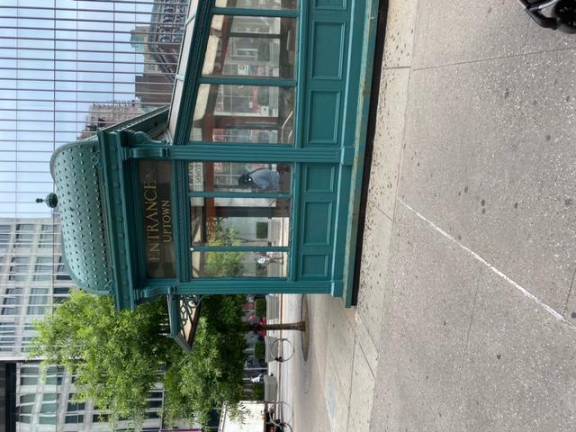Invisible Riders: Subways and Accessibility
The current state of downtown trains - and the route to greater access




Most New Yorkers have a love-hate relationship with the MTA, but while the iconic transit authority might be occasionally irritating to the average commuter, it provides countless more difficulties for individuals with disabilities. Disability advocacy has grown in recent years, with organizations such as Disability Pride NYC spreading awareness through events such as the annual Disability Pride Parade. While the parade, which happens every July in honor of Disability Pride Month, is postponed this year due to COVID concerns, organizations are working to make everyday necessities, such as the subway, more inclusive of disabled people.
NYC currently has 118 active accessible subway stations out of 472 total stations, including the Staten Island railway; 25 percent accessibility may seem like a good start, but not all of these accessible stations provide full access – some only provide access to certain train lines, even if the station is a stop for many different lines. There is also no uniform design of accessible and inaccessible stations, making each subway stop a unique experience for commuters and MTA employees. While the MTA has recently expanded its accessible stations in places like Brooklyn’s Avenue H station, led by Chief Accessibility Officer Quemuel Arroyo, the wide variety of downtown Manhattan’s subway stations show just how stark these differences in accessibility can be.
Transit Workers’ Perspectives
The 14th St. Union Square station is always a hub of activity, offering access to the L, N, Q, R, W, 4, 5 and 6 train lines. Its sole elevator qualifies it to be marked as an “accessible” station, but it lacks accessible access to the 4, 5, and 6 lines due to their positioning in relation to the elevator. While this may be frustrating to some riders, it does not prevent the station from being full of traffic at all times, with the elevator almost always in use. This was confirmed by the MTA employee in one of Union Square’s many ticket booths, who noted that people often come to the station because they need to use the elevator. (This employee, along with most others interviewed, requested to keep her identity anonymous.) When asked about accessibility complaints, she replied that she hadn’t received any in her time working in this station.
Similar to 14th St., other accessible stations in downtown Manhattan are hubs of activity where many different train lines stop. West 4th St. was so busy that the sole booth staffer could not answer questions, while Broadway-Lafayette was full of confused passengers clamoring to receive assistance in buying a MetroCard.
The booth employee, struggling with a broken microphone, had to exit the booth to point some tourists on their way before mentioning that in his experience, not a lot of disabled people used the station. As Broadway-Lafayette boasts two elevators rather than one and offers access to five different train lines, this was surprising. However, the crowding of the station, and lack of helpful resources such as a working booth microphone or cash in the ticket booths, might deter not just physically disabled people, but anyone with impaired functioning from braving the subway.
“It’s hard for them, when you have a cane and you’re walking down stairs, you really feel it in your knees and back,” said an MTA employee at the Astor Place station, an inaccessible station with steep stairs that lead to only the 6 train. As busier stations are typically the ones with ADA-approved facilities, it is no surprise that Astor Place lacks these amenities. What was surprising, though, was how certain this employee was of the difficulties faced by those even without severe mobile disabilities, pointing to a larger issue of minimal accommodations and performative fixes.
More than Mobility
These sentiments were most strongly expressed by an employee at the inaccessible Christopher St. Station. To him, the issue of accessibility goes far beyond providing for those with obvious physical disabilities. Included in this categorization are people with cognitive disorders such as autism, which often require special assistance that is simply not provided at these stations currently. “Sometimes they don’t know how to work the [MetroCard] machines,” the employee noted, describing instances in which commuters with mental disabilities would get frustrated when ticket machines didn’t work and subsequently have meltdowns. Instead of aides or special needs counselors, workers are instructed to call the police when a customer has a meltdown, which often exacerbates the situation. In this employee’s view, the police are “not at all” equipped to deal with mentally ill or neurodivergent individuals, which makes the transit system implicitly unwelcome to them.
In addition to people with mental disabilities, this employee also says that the MTA has not dealt adequately with senior citizens, as many do not know how to operate the new MetroCard machines and are left stranded. And like Broadway-Lafayette, the Christopher St. booth also has no cash for customers who want to buy MetroCards. Some station entrances don’t have booths at all, leaving commuters helpless if they can’t figure out the technology. While he knows the MTA has plans for increasing accessibility for everyone, this employee can’t help but wonder why they don’t immediately address simple fixes, such as supplying ticket booths with cash, that would make commuters’ lives exponentially easier. “It’s depressing, because I don’t feel like we’re giving [disabled commuters] that service [they deserve],” he sighed.
The MTA’s website offers accessibility resources that include a list of accessible stations, reduced fare qualifications, and an overview of current projects that aim to increase accessibility, such as the Jay Street Accessibility Lab. Press releases boast accomplishments such as 57th St.’s addition of an elevator and expanded mezzanine, making it accessible to riders with mobile disabilities. Although initiatives like this are focused on physical disabilities, they are still important steps forward, especially as the MTA’s accessibility plans were slightly derailed last year due to budget cuts from the COVID-19 pandemic, which led to a loss in revenue for the MTA. The departure of former MTA president Andy Byford, who was a champion of accessibility planning, also inhibited the speed of accessibility rollouts. The MTA maintains that it is doing what it can in the face of enormous financial strain, which hinders optimal renovation and resource distribution. Still, lawsuits have been filed against the MTA for unfair refusal of service, some of which are currently ongoing.
The Future of Accessibility
On July 15, the Avenue H Q station, usually quiet save for a few passerby, was abuzz with activity. Elected officials, activists, and MTA employees stood in front of microphones and cameras to announce the completion of the station’s renovation, which makes it the newest ADA-approved subway station in NYC. Instead of an elevator, the station now boasts a ramp, accessible turnstiles, and new roof and lighting fixtures, all designed to make entering and exiting the station as easy as possible.
The project was championed by Quemuel Arroyo, MTA’s first Chief Accessibility officer, who noted that “there is no fail point here from now on,” as ramps are far less likely to break down than elevators. Arroyo pointed out the significance of there no longer being any alternate route instructions for people with disabilities, as they could now use the Avenue H station instead of going out of their way to find others to accommodate them. His remarks highlighted the fact that many able people take transportation for granted, while for disabled people, every new station is a leap forward in accessibility.
MTA Project Manager Barney Gray explained that it had been in the works for over 10 months, costing about $12.2 million. Avenue H’s renovation is the first completed project in the MTA’s 2024 Capital Plan, their 4-year plan to improve transportation based on community needs. The voice of the community is especially important in shaping the MTA’s goals, as Arroyo said that only by working with commuters and community organizations can the MTA decide which stations are prioritized in accessibility projects.
Another thing the MTA has to consider is the foundational architecture of subway stations, many of which are over 100 years old. The infrastructure of these stations were often not built with disabled people in mind, so changing the structure to accommodate for disabilities often means disrupting deep structures, which can take a lot of money and time, often causing service changes. Still, the results are worth the struggle, as Assembly Member Robert Carroll said that accessibility means that everyone will get to enjoy “the great benefits of being a New Yorker” and that the new station has made “the neighborhood a better place for all of us.” Many MTA officials and community board leaders are already looking forward to future projects, preparing for more hard work in making NYC’s subways available to everyone regardless of ability.
In the meantime, individuals with disabilities can turn to other organizations when the MTA-run subway system fails them. One such organization is Disabled in Action (DIA) of Metropolitan New York, a civil rights organization that aims to raise awareness about disability rights, pass pro-disability legislation, and provide a platform for disabled activists to reach the surrounding community. Its long list of resources has specific information for many different disabilities while also providing transit information. Another program that is specifically for individuals with mobile disabilities is called Accessible Dispatch, which connects disabled individuals with taxis at no extra cost, ensuring that even if the subway doesn’t work, people won’t be stranded. The MTA also has a paratransit service that just resumed shared rides since the pandemic began.
But while these efforts are beneficial to the disabled community, many long for a day when they are no longer needed, a day when disabled people have the same access to MTA facilities as everyone else. In the words of Arroyo, the MTA “can take on ADA projects as long as the willpower and resources are there.” All that remains is for them to follow through.